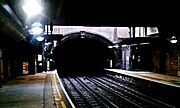Great Portland Street tube station
| Great Portland Street | |
|---|---|
 Station as seen from above looking north towards Regents Place | |
| Location | Great Portland Street |
| Local authority | City of Westminster |
| Managed by | London Underground |
| Number of platforms | 2 |
| Fare zone | 1 |
| London Underground annual entry and exit | |
| 2018 | |
| 2019 | |
| 2020 | |
| 2021 | |
| 2022 | |
| Key dates | |
| 10 January 1863 | Opened |
| Other information | |
| External links | |
| Coordinates | 51°31′26″N0°08′38″W/ 51.5238°N 0.1438°W |
Great Portland Streetstation is aLondon Undergroundstop betweenBaker StreetandEuston Squarestations. It lies on theCircle,Hammersmith & CityandMetropolitanlines.Great Portland Streetstation is listed as a building of National Significance and is inTravelcard Zone 1.[6]
History
[edit]The station was part of the world's first underground railway, theMetropolitan Railway,which opened between "Bishop's Road" (nowPaddington) on the Hammersmith & City line and "Farringdon Street" (close to the present-dayFarringdonstation). It was opened on 10 January 1863 as "Portland Road", changed to its present name on 1 March 1917 but was renamed "Great Portland Street and Regents Park" in 1923 and then reverted to its present name in 1933.[7] The current structure was built in 1930 on a traffic island on theMarylebone Roadat its intersection withGreat Portland Streetand Albany Street. Its construction is a steel framed cream terracotta clad exterior, with the perimeter providing shops and originally a car showroom with office space over the station. Great Portland Street was at a major sales location for the motor industry. It was designed by the Metropolitan Railway's architect C. W. Clark and was Grade II-listed in January 1987.[8]
The station lies at the northern end of Great Portland Street – a main road which marks the border betweenMaryleboneandFitzrovia.[9][10]
The local neighbourhood plan identified the gyratory around Great Portland Street Underground Station as one where public realm improvements and traffic calming should be made.[11]
Services
[edit]The station is served by theMetropolitan,Hammersmith & CityandCirclelines, betweenEuston Squarein the east andBaker Streetto the west. All three lines share the same pair of tracks fromBaker StreetJunction toAldgateJunction making this section of track one of the most intensely used on the London Underground network.
Circle line
[edit]The typical service in trains per hour (tph) is:[12]
- 6 tph clockwise via Kings Cross St Pancras and Liverpool Street
- 6 tph anti-clockwise to Hammersmith via Paddington
Hammersmith & City line
[edit]The typical service in trains per hour (tph) is:[12]
- 6 tph eastbound to Barking
- 6 tph westbound to Hammersmith via Paddington
Metropolitan line
[edit]The typical off-peak service in trains per hour (tph) is:[13]
- 12 tph eastbound to Aldgate
- 12 tph westbound via Baker Street:
- 2 tph to Amersham
- 2 tph to Chesham
- 8 tph to Uxbridge
The typical peak time service in trains per hour (tph) is:[13]
- 14 tph eastbound to Aldgate
- 14 tph westbound via Baker Street:
- 2 tph to Amersham
- 2 tph to Chesham
- 4 tph to Watford
- 6 tph to Uxbridge
| Preceding station | Following station | |||
|---|---|---|---|---|
| Baker Street towardsHammersmith
|
Circle line | Euston Square towardsEdgware RoadviaAldgate
| ||
| Hammersmith & City line | Euston Square towardsBarking
| |||
| Baker Street | Metropolitan line | Euston Square towardsAldgate
| ||
| Former services | ||||
| Baker Street towardsHammersmith
|
Metropolitan line Hammersmith branch(1864–1990)
|
Euston Square towardsBarking
| ||
Connections
[edit]The station is served byLondon Busesday and night routes.
Gallery
[edit]-
Station as seen from above looking north
-
Original Metropolitan Steam Train passes through Great Portland Street Station
-
Platform roundel
-
View of station location circa 1790
-
Station tunnel running under Marylebone Road
-
Shown as the Metropolitan Railway's Portland Road Station in 1862
-
Thomas Crane's 1883 poster of Portland Road Station
-
Trial 1862 train journey passing Portland Road station.
References
[edit]- ^"Station Usage Data"(CSV).Usage Statistics for London Stations, 2018.Transport for London.23 September 2020.Archivedfrom the original on 14 January 2023.Retrieved11 October2023.
- ^"Station Usage Data"(XLSX).Usage Statistics for London Stations, 2019.Transport for London.23 September 2020.Archivedfrom the original on 9 November 2020.Retrieved9 November2020.
- ^"Station Usage Data"(XLSX).Usage Statistics for London Stations, 2020.Transport for London.16 April 2021.Retrieved1 January2022.
- ^"Station Usage Data"(XLSX).Usage Statistics for London Stations, 2021.Transport for London.12 July 2022.Retrieved7 September2022.
- ^"Station Usage Data"(XLSX).Usage Statistics for London Stations, 2022.Transport for London.4 October 2023.Retrieved10 October2023.
- ^Historic England."Great Portland Street Underground Station (1213650)".National Heritage List for England.Retrieved28 September2015.
- ^Forgotten Stations of Greater London by J. E. Connor and B. Halford
- ^London Underground Station Heritage Board, retrieved 10 January 2013[full citation needed]
- ^"About us".Fitzrovia Neighbourhood Association.2 April 2012.Archivedfrom the original on 31 May 2014.Retrieved10 May2014.
- ^"The Marylebone Association Constitution"(PDF).14 May 1996.Retrieved10 May2014.[permanent dead link]
- ^Fitzrovia West Neighbourhood Forum (6 May 2017)."PEDESTRIANISATION OF OXFORD STREET | FitzWest".fitzwest.org.Archivedfrom the original on 15 June 2018.Retrieved15 June2018.
- ^ab"Circle and Hammersmith & City line WTT"(PDF).Transport for London.Archived fromthe original(PDF)on 11 November 2016.
- ^ab"Metropolitan line WTT"(PDF).Transport for London.Archived fromthe original(PDF)on 1 July 2016.
External links
[edit]- Rail transport stations in London fare zone 1
- Circle line (London Underground) stations
- Hammersmith & City line stations
- Metropolitan line stations
- Tube stations in the City of Westminster
- Former Metropolitan Railway stations
- Railway stations in Great Britain opened in 1863
- Great Portland Street
- 1863 establishments in England
- Charles Walter Clark railway stations
- Grade II listed railway stations
- Grade II listed buildings in the City of Westminster









